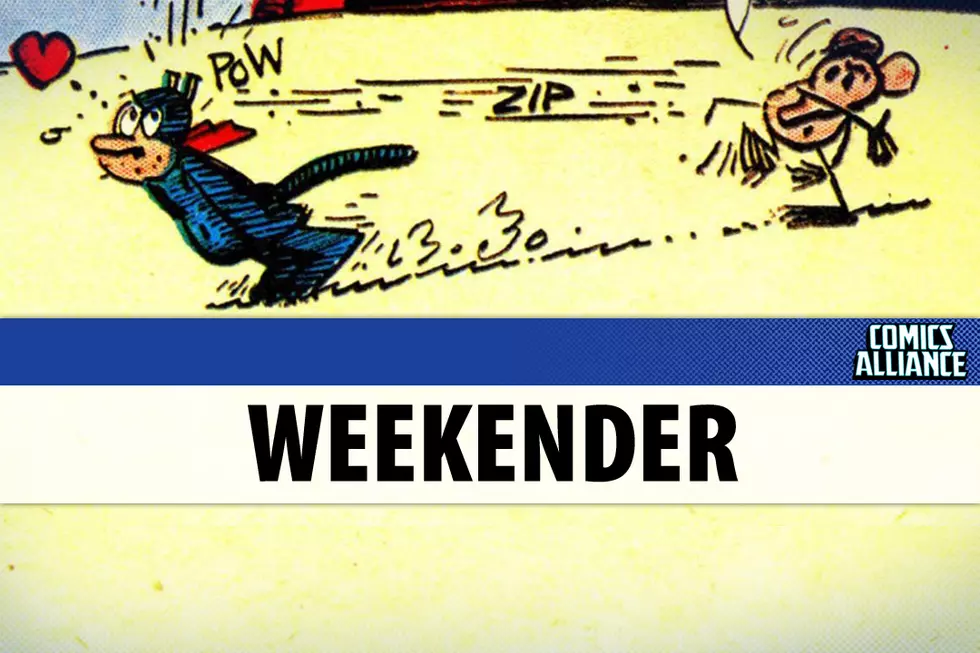
‘Baja': The Best Noir Comic Set in the Desert

Good crime comics used to be so hard to find. After the Comics Code Authority spelled doom for the genre after their heyday in the '40s and '50s, they virtually disappeared from the medium for decades. Thanks to the efforts of creators like Ed Brubaker, Darwyn Cooke, Brian Michael Bendis, Brian Azzarrello and the inimitable David Lapham and books like xxxx, the 2000s saw a resurgence in noir that helped the genre gain a foothold once again. Now, in the 2010s, I believe we're entering the second generation of the noir comic resurgence. And there lies IDW's Baja.From newcomers Ben Wagner on script and Nathan St. John handling art, Baja is a story of love, theft, heartbreak, and betrayal set in the sun-bleached xeric of the Baja California Desert. It's an apt setting for noir and crime - the heat and desolation of the environment provide a perfect metaphor for the isolation and desperation of a life on the fringes of society. Many stories have been set in these environs, but it's hard to recall one so deeply embedded in the barren stretches of sand and baked earth.

Baja is a story that takes advantage of multiple perspectives, intertwining stories, and non-linear time. It's daring enough to begin with a scene that actually occurs at the end of the story - a trick that's more often used in film, many times unnecessarily, but here it works. A man and woman - Zack and Hil - on a drive through the Baja Peninsula, obviously looking forward to their place in the sun after a big score. Before they can reach their destination, though, a mysterious truck is on their tail and harassing them. It's frantic and mysterious, and right when things look really hairy, Part One of the book is over, and we're in a different time and place entirely.
At the center of the book is Zack Townsend, a normal guy made minor celebrity by a random act of heroism. Months before meeting Hil, the genre-requisite femme fatale in the car, Zack is married to Moira, with whom he expects a baby. Though he loves Moira, he has no interest in being a father, and his indifference is apparent. Returning from a fresh sonogram, Zack and Moira stumble into an active bank robbery. As the robber attempts to flee, he tries to commandeer a vehicle, killing the driver and wrecking the car in the process. When he turns his gun on Zack and Moira, Zack does what he thinks any man would do: guns the accelerator and mows the shooter down.
Afterwards, Zack is treated like a hero, honored, even being written up in Time magazine. But the trauma of the event causes Moira to miscarry, driving a permanent wedge between the two. They split up, and even as Zack's profile continues to rise, the guilt weighs him down. After drifting in this conflicted state for a while, he meets Hil, who treats him like a celebrity, and a hero, and immediately provides the spark he had been missing. As she encourages him to cash in on his notoriety while he still has time, it becomes clear Hil is the type of girl who is always looking for something more. That's almost never good.

Parallel to the story of Zack and Hil is the story of Blaine and Lana, a highly successful couple just on the verge of biting off more than they can chew. They're about to make a 250,000 dollar payment on a new, one-million dollar house, and Blaine is clearly not as comfortable with the situation as Lana. Though obviously uneasy with the financial strain, he's willing to bear the burden to keep his relationship stable. But a pair of masked intruders even manage to throw that to hell.
Baja is about relationships. The couples in this book -- Zack and Moira, Zack and Hil, Blaine and Lana, Hil and her Mystery Boyfriend (a nice twist) -- are all in and out of various stages of love and tolerance and trust, and all things they're willing to do to get what they feel they deserve. There's some very good character work here, with fully-shaded people making interesting choices, and the reasons behind those choices being revealed in time. There's some nifty writing on display, especially when Wagner works with the couples one-on-one, and dialogue that doesn't refer on cliche. In one of the more fascinating bits, Blaine talks about keying his own car: "I was distracted, I was aiming for the lock and missed. I jabbed the paint. Made a little ding. Then I just...scraped it across the paint to hear the noise. Left a six inch gash." Gems of original speech like that glitter here and there throughout.

Nathan St. John's artwork is original, too. Thick and moody ink washes set some evocative scenes, particularly when in the desolation of the desert itself. His sense of mood and setting is impressive, and the blacks and grays of his brushlines against shifting gray backgrounds always make interesting pages, especially in those few instances of red color pops. His character work leaves a lot to be desired - everything is done with brush, and there's a mild abstract bent in his approach, so it can sometimes to difficult to tell who one is actually looking at. But clearly, there's a lot of talent to build on.
There are still nits to pick about Baja. With all the time-skipping and perspective-shifting, there seems to be an affinity for the films of Christopher Nolan, and the games of disclosure that implies. It's occasionally hard to tell where and when you are because of St. John's artwork and the minimal detail used in establishing scenes, though that may be partly intentional, and the lettering is all pretty hard to read anyway, usually against black backgrounds. More could have been done to make the book easier on these bloodshot old eyes.
Those are just gripes, though. Baja is a moody crime story told with strong characters and agile narrative twists, and a fitting entry into crime comics' growing lexicon.
Buy Baja at your local comic shop or online.
More From ComicsAlliance



![Mairghread Scott Brings Windblade Soaring Back, Just in Time for “Transformers: Combiner Wars” [Interview]](http://townsquare.media/site/622/files/2015/01/windblade-hed.jpg?w=980&q=75)





